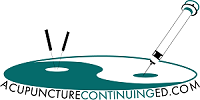NEW MEXICO
New Mexico has two levels of scope of practice. Expanded Practice practitioners can inject
16.2.2.8 SCOPE OF PRACTICE: Pursuant to Section 61-14A-3 NMSA
1978, the practice of oriental medicine in New Mexico is a distinct system of primary
health care with the goal of prevention, cure, or correction of any disease, illness,
injury, pain or other physical or mental condition by controlling and regulating the flow
and balance of energy, form and function to restore and maintain health. Oriental
medicine includes all traditional and modern diagnostic, prescriptive and therapeutic
methods utilized by practitioners of acupuncture and oriental medicine. The scope of
practice of doctors of oriental medicine shall include but is not limited to:
A. evaluation, management and treatment services;
B. diagnostic examination, testing and procedures;
C. the ordering of diagnostic imaging procedures and laboratory or
other diagnostic tests;
D. the surgical procedures of acupuncture and other related
procedures;
E. the stimulation of points, areas of the body or substances in the
body using qi, needles, heat, cold, color, light, infrared and ultraviolet, lasers, sound,
vibration, pressure, magnetism, electricity, electromagnetic energy, bleeding, suction,
or other devices or means;
F. physical medicine modalities, procedures and devices;
G. therapeutic exercises, qi exercises, breathing techniques,
meditation, and the use of biofeedback devices and other devices that utilize heat, cold,
color, light, infrared and ultraviolet, lasers, sound, vibration, pressure, magnetism,
electricity, electromagnetic energy and other means therapeutically;
H. dietary and nutritional counseling and the prescription or
administration of food, beverages and dietary supplements therapeutically;
I. counseling and education regarding physical, emotional and
spiritual balance in lifestyle;
J. prescribing, administering, combining, providing, compounding
and dispensing any non-injectable herbal medicine, homeopathic medicines, vitamins,
minerals, enzymes, glandular products, natural substances, protomorphogens, live cell
products, amino acids, dietary and nutritional supplements; cosmetics as they are
defined in the New Mexico Drug, Device and Cosmetic Act and nonprescription drugs
as they are defined in the Pharmacy Act;
K. the prescription or administration of devices, restricted devices and
prescription devices as defined in the New Mexico Drug, Device and Cosmetic Act
(Section 26-1-1 NMSA 1978) by a doctor of oriental medicine who meets the
requirements of 16.2.2.9 NMAC.
[16.2.2.8 NMAC – Rp, 16.2.2.8 NMAC, 02-15-05; A, 11-28-09]
16.2.2.9 DEVICES, RESTRICTED DEVICES AND PRESCRIPTION
DEVICES: The board determines that devices, restricted devices and prescription
devices as defined in the New Mexico Drug, Device and Cosmetic Act (Section 26-1-1
NMSA 1978) are necessary in the practice of oriental medicine. Doctors of oriental
medicine who have the training recommended by the manufacturer of the device shall
be authorized to prescribe, administer or dispense the device.
[16.2.2.9 NMAC – Rp, 16.2.2.9 NMAC, 02-15-05; A, 11-28-09]
16.2.2.10 SCOPE OF PRACTICE FOR EXPANDED PRACTICE:
A. In addition to the scope of practice for a licensed New Mexico
doctor of oriental medicine, the scope of practice for those certified in expanded
practice shall include certification in any or all of the following modules: basic
injection therapy, injection therapy, intravenous therapy and bioidentical hormone
therapy. practitioners previously certified as Rx1 extended prescriptive authority, will
be certified for basic injection therapy and practitioners previously certified as Rx2
expanded prescriptive authority, will be certified for injection therapy, intravenous
therapy and bioidentical hormone therapy.
B. The expanded practice shall include:
(1) the prescribing, administering, compounding and dispensing of
herbal medicines, homeopathic medicines, vitamins, minerals, amino acids, proteins,
enzymes, carbohydrates, lipids, glandular products, natural substances, natural
medicines, protomorphogens, live cell products, gerovital, dietary and nutritional
supplements, cosmetics as they are defined in the New Mexico Drug, Device and
Cosmetic Act (26-1-1 NMSA 1978) and nonprescription drugs as they are defined in
the Pharmacy Act (61-11-1 NMSA 1978); and
(2) the prescribing, administering, compounding and dispensing of the
following dangerous drugs or controlled substances as they are defined in the New
Mexico Drug, Device and Cosmetic Act, the Controlled Substances Act (30-31-1
NMSA 1978) or the Pharmacy Act:
(a) sterile water;
(b) sterile saline;
(c) sarapin or its generic;
(d) caffeine;
(e) procaine;
(f) oxygen;
(g) epinephrine;
(h) vapocoolants;
(i) bioidentical hormones; and
(j) biological products, including therapeutic serum.
C. When compounding drugs for their patients, doctors of oriental
medicine certified for expanded practice and prescriptive authority shall comply with
the compounding requirements for licensed health care professionals in the United
States pharmacopeia and national formulary.
[16.2.2.10 NMAC – N, 02-15-05; A, 11-28-09]
16.2.2.11 [RESERVED]
[16.2.2.11 NMAC – Rp 16.2.2.10 NMAC, 02-15-05; Repealed, 11-28-09]
16.2.2.12 PRESCRIPTION PADS: A doctor of oriental medicine, when
prescribing, shall use prescription pads imprinted with his name, address, telephone
number and license number. If a doctor of oriental medicine is using a prescription pad
printed with the names of more than one doctor of oriental medicine, each doctor of
oriental medicine shall have a separate signature line indicating the name and license
number. Each specific prescription shall indicate the name of the doctor of oriental
medicine for that prescription.
[16.2.2.12 NMAC – Rp 16.2.2.11 NMAC, 02-15-05; A, 11-28-09]
